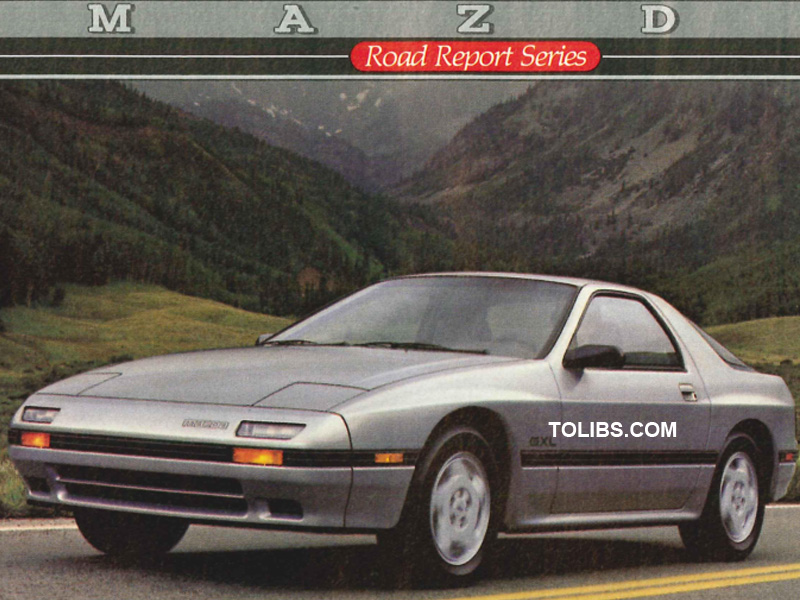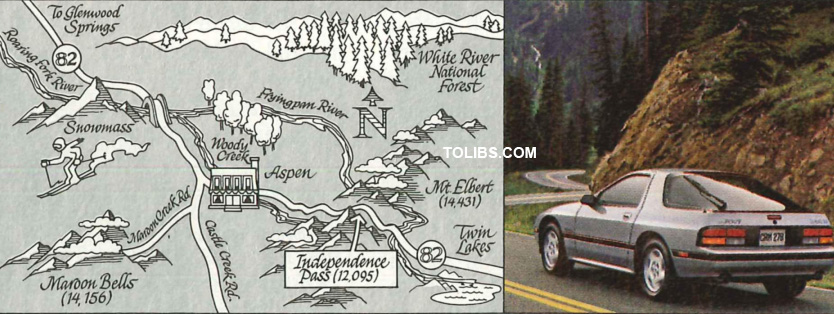The Mazda RX-7 1986

The New-Generation Mazda RX7
A sophisticated new sports car carves its way through a Colorado mountain range once carved by glaciers.
Few sports cars would be as tough an act to follow as the Mazda RX-7. And few roads carve trails as tough to follow as those scaling Colorado's Rockies. Combine the two and you've got a mighty challenge.
Introducing the 1986 Mazda RX-7 GXL. An all-new challenger to follow up the toughest act going and to carve those Rockies down to size.
The 1986 RX-7 GXL represents a brand-new idea in sports cars. Only two ingredients remain from the original RX-7 concept: The legendary rotary engine, and an equally legendary spirit of exhilaration in sports car driving.
Everything else is new. Everything.
The sleekly aerodynamic, wind tunnel tuned exterior boasts a Cd of only 0.31, with the style of flared fenders that cover, only barely, the muscle of low-profile, ultra performance, unidirectional tires.
Underneath that stunning shape is a new level in automotive technology. In front, an advanced concept in MacPherson strut suspension includes aircraft-grade, castaluminum control arms. In the rear the independent, Dynamic Tracking Suspension System (DTSS) represents a major breakthrough in vehicle dynamics technology.
Utilizing ingenious Triaxial Floating Hubs that pivot about trailing arms, DTSS reacts to any combination of road or driving situations by adjusting rear wheel toe angles to optimum for the particular condition, whether it be acceleration, braking or cornering.
In addition, a separate mechanism provides precise control of wheel camber. Thus, incredible as it sounds, the rear wheels actually contribute to steering the RX-7 around a turn with unbelievable exactness.
Anti-roll bars are fitted front and rear. And this RX-7 includes Automatic Adjusting Suspension (AAS), which allows individual tailoring of hock absorber rates at the touch of a console mounted switch.
Among the new RX-7's many capabilities is its uncanny ability to interact with you and the road beneath you. The result is a whole new dimension in handling. And up here where the edge of pavement, cliff and sky are one, that sure feels good.

Rack-and-pinion steering electronically varies assist as a function of vehicle speed and cornering force. Brakes are enormous four-wheel ventilated discs, with aluminum, four-piston front calipers.
All this could describe a state-of the-art race car. For a production sports car in the RX-7's category, this combination of features is without precedent. Finally, under the hood is the race-proven electronically fuel-injected 13B rotary, smooth as silk, refined to deliver more power, torque and efficiency than ever.
This is a sports car not in awe of tough challenges. Or high Colorado mlountain roads. Head outside Aspen for a morning call on Maroon Bells' twin peaks, still slumbering under last night's bedcovers of downy-soft clouds. Sunshine hasn't yet awakened the coming sparkle of summer aspengroves. But watch out: The road's twists and turns never sleep.
Or shinny out Highway 82, pavement with only a crumbling grip on a valley wall above the Roaring Fork River. Somebody musta tooken off after a cantankerous mountain goat, and the next guy down the path called it a road. Highway 82 gives switch backs a bad name one stumble and the unwary will end up in a glacial valley with the rest of a millenium's fodder.
Inklings of roads like these brought the RX-7 GXL to reality. Up here, when the edges of pavement, cliff and sky are one, on roads engineered by mountain goats, results alone count-excuses just won't do. Up here, the mediocre timidly ask permission to pass. But up here, the RX-7 GXL can level the climbs, steer corners true, dynamically track the razor-line border of road, earth and empty sky.
And as the path tops the Continental Divide at 12,095 feet, Independence Pass, Colorado, it's all clear as a Rocky Mountain sky: The 1986 Mazda RX-7 GXL has been engineered for a drive over the top of the world.












